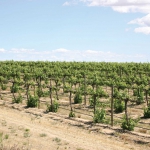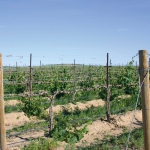Last winter should have been a mild year for winter cold damage to wine grapes in Washington. But after many reports of cold damage-like symptoms last spring, Washington State University researchers have refocused attention to vine roots and cold soil temperatures.
Arctic freezing temperatures in winter and cold temperatures in early fall or late spring are hazards of growing vinifera wine grapes in the Pacific Northwest. Every few years, grapevines somewhere in the Northwest experience damage from cold temperatures, which is why WSU tracks grape cold hardiness and has developed a cold hardiness model to give growers early warning if they’ve experienced damaging temperature thresholds. (See “Predicting cold hardiness.”)
Researchers know a lot about bud, phloem, and xylem cold damage that occurs in grapevines, but not much about vine root cold hardiness.
Buds are moderately susceptible to cold damage and cannot be repaired; however, vines have essentially three sets of buds (primary, secondary, and tertiary) that work as a backup plan.
Damage to phloem (vascular tissue that conducts sugars and metabolic products from the leaves to other plant parts) occurs almost annually in Washington because phloem is the most cold-sensitive tissue. Though phloem cells are not repairable, they are easily replaced by reorganization of nearby cells. Xylem, the vascular tissue that conducts water and nutrients from the roots to other plant parts, is the least susceptible to cold damage, but xylem damage is more serious because it hinders the vine’s ability to uptake water.
But what about cold damage to grapevine roots?
Root cold hardiness
The 2013-14 winter was relatively mild and had no major cold events, no long duration of cold, and decent temperatures in fall and spring to bring vines in and out of dormancy, said Dr. Michelle Moyer, WSU extension viticulture specialist. “But we (WSU) got a lot of calls and reports later in the spring of cold damage-like symptoms—damage in a year that we shouldn’t have.”
The reports got WSU researchers wondering how cold damage symptoms could have happened without typical cold damage-inducing temperatures.
“We know very little about root cold hardiness,” she said during the annual meeting of the Washington State Grape Society. “Do roots acclimate like buds and canes? Do they have a kill threshold? We know a lot about what above-ground cold temperatures do to vines, but what about cold temperatures and roots?”
General information says that root damage occurs at soil temperatures of 21° to 23°F, she reported. “But do roots respond to temperature like buds and canes, and if so, which is more important, severity of cold or sudden change in temperature?”
She explained that water in the soil can act as a temperature buffer and delay how fast the soil cools down in the fall and how slowly it warms up in the spring. The air between soil particles will change temperature more rapidly than water between soil particles.
Thus, soil water-holding capacity can influence the cold damage to roots. Two nearly identical vineyards within a quarter-mile of each other (same owner, same variety) suffered vastly different damage from the 2010 Thanksgiving freeze. The vineyards experienced similar above temperatures, but one had only mild cold damage and the other required bulldozing and replanting of the vines. Soil variation, which resulted in slightly different soil temperatures between the two vineyards, was the only difference, explained Moyer.
Root damage can be difficult to identify because symptoms are not always distinct. Symptoms include delayed, slowed, or uneven bud break; slow shoot development and shoot collapse; stunted, yellowed shoots; shoots that are easily desiccated during warm spring days or days with high wind; and lack of suckers.
Symptoms
“Symptoms are not always consistent and may seem sporadic and random until you think about soil types,” Moyer said. Often, one side of the vine will be fine while the other is partly dead or has no bud break. Symptoms are usually patchy throughout the vineyard because damage is restricted to areas of the vineyard where soil water-holding capacity is less and drainage is more.
“If you have erratic bud break but no suckers coming up, that’s an indication of root damage,” she added.
Other signs are damage in locations not typical with cold damage (such as an area where cold air drains instead of pools) or damage in sandy soil locations. “At first, you think the damage is erratic when you look at individual vines,” she said. “But if you step back and look at the whole vineyard, you’ll see the soil connection.”
Fall irrigation
Fall irrigation after harvest is a critical management step in preventing root damage because adequate soil moisture can help insulate roots. Replenishing the soil profile with moisture after harvest is the only thing growers can do to prevent root damage.
“When we have dry winters, we need to be particularly cognizant of soil temperatures and be aware of potential for damage,” she said, adding that in dry winters, carryover of soil moisture is important.
If there’s been root damage, get water on in the spring as soon as possible to help the vine uptake water, she advised. No sucker growth at all indicates that it will be difficult for the vine to make complete repair, so additional management steps will be needed.
Bud numbers may need to be reduced, thereby reducing the number of developing shoots, if damage is severe. “The more buds you have, the more shoots, and the more shoots, the more water demand is placed on the vine with a damaged root system. Yield may also need to be reduced to lessen the water demands of the vine,” said Moyer.
She advised growers with root damage to be cautious of using deficit irrigation. “You don’t want to apply additional water stress to vines that may need a little extra help.” •
For more information about grape cold hardiness, visit WSU’s website at wine.wsu.edu/research-extension/weather/cold-hardiness/








Leave A Comment